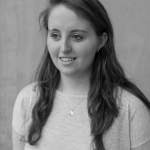A new standard for health and well-being: HS2 quiet spaces technical specification
HS2 Ltd has strategic goals for setting new standards for customer experience and health and safety in the operation of the railway and therefore requires its designers to take an inclusive design approach so that infrastructure is designed for the people who use it, both customers and staff. Providing quiet spaces for people from religious and non-religious backgrounds, and people with different neurological backgrounds is essential to this.
Existing standards recommend spaces are provided, however, these are insufficiently developed to allow consistency across HS2 infrastructure. HS2 Ltd therefore commissioned the Phase 1 Engineering Delivery Partner (EDP) to research user requirements, determine space provisions and develop a specification for use by station designers.
The outputs of the research provides a standard design approach for customer and staff facilities, defines sizes for stations, and includes a sizing method which can be adapted for other facilities. The specification is now included in the HS2 standards baseline for Phase 1 and is in the process of being implemented in the station designs.
The specification has potential to influence development of national standards and have a wider impact in promoting health and wellbeing by reducing barriers to accessibility to transport infrastructure and other public spaces.
Introduction
It is not unusual for people to find themselves needing to find peace and quiet at some point during their day. For many this might be once they have reached home. However, for some this need may present itself when out and about during their day or at work. This might be to have a break, stop and think, contemplate or pray. For some people it may be because they have reached a point where they are experiencing sensory overload and need somewhere to manage their sensory processing needs. Busy transport hubs and terminals are typically places with high sensory intensity, therefore increasing the likelihood of individuals feeling overwhelmed and experiencing sensory overload.
Consequently, there is significant health and wellbeing benefit in providing quiet spaces within these environments. Providing quiet spaces can help remove barriers to use of the transport network by customers, and to employment for staff. Such a provision is fully aligned with the HS2 Equality, Diversity and Inclusion Policy [1] which sets out how HS2 Ltd and its suppliers will address the needs of people who have protected characteristics as specified within The Equality Act (2010) [2].
This technical paper describes the research and design process by which a new technical specification has been set for the design of quiet spaces at HS2 stations, as well as the key findings of the research underpinning it and resulting recommendations for their design.
Whilst existing standards recognise the need for quiet spaces in public buildings there is currently no guidance on how to size or design them. In 2021, HS2 Ltd commissioned Atkins, part of the joint venture Engineering Delivery Partner (EDP) for HS2 Phase One, to undertake research and develop a specification to address this. The research included review of existing studies, standards and demographic information; user engagement interviews to help identify requirements; a design study to determine how these requirements could be met; and reviews with subject matter experts and a variety of stakeholders to obtain feedback and test proposals.
The research identified key design principles which informed the final specification, including:
- Providing quiet spaces using a ‘cellular’ approach or as a series of rooms, allows different types of users to be accommodated at the same time whilst avoiding potential conflicts which might arise if they had to use the same room.
- Providing rooms of a ‘neutral’ design means they can be conducive to the needs of a wide range of users, including people from different religious and non-religious backgrounds, as well as to people with different neurological needs, from neurotypical to neurodiverse, thereby making the best use of available space, an important consideration in station design.
- Understanding potential demand by faith and neurodiverse users and their different patterns of use through the day and week allows the overall space provision at each station to be optimised.
- That quiet spaces for customers and staff should be provided as separate dedicated facilities to ensure that each of these groups is comfortable using the facilities.
- That designating suitable areas outside stations and on station concourses as quiet zones can be an additional means of providing quiet spaces for customers and staff.
Developing these principles into a detailed specification allows HS2 Ltd to provide unambiguous guidance to station designers on a hitherto less well understood subject to ensure consistent designs across all stations. This supports fulfilment of HS2 Ltd’s strategic goals to set new standards for customer experience and for health, safety and wellbeing in the operation of the railway.
Developing the specification
The development of the specification was initially planned to follow a series of stages. In practice these stages became more intertwined as it was found that each workstream informed the other:
- The first stage was a review of current best practice and built examples of existing equivalent facilities and preparation of a commentary on considerations relevant to HS2. This stage developed to include interviews with operators which contributed valuable information about what works and what doesn’t.
- The second stage was to identify the basis for any requirements in the context of the Equality Act (2010) [2] by undertaking an assessment to capture potential impacts on people using stations in relation to the protected characteristics of religion and belief and disability and to capture specific mitigations to address these impacts. This stage developed to include user group identification and a user engagement survey to help identify requirements which could then be translated into specific provisions within a design proposal.
- Building on the outputs of the first and second stages, the third was to develop a design proposal and summary of operational considerations and refine these through engagement with stakeholders. This stage developed to include assessment of demographic data and development of a sizing method for the facilities so that space could be optimised at each station. This stage also involved extensive design reviews with subject matter experts and stakeholders, with a particular emphasis on security, operations and maintenance to ensure the facilities could be accommodated within operational plans.
- The fourth stage was to translate the design and operational considerations into a clear and succinct specification for use by station designers.
The development of the specification was led and managed by a small working group of inclusive design experts, human factors specialists and architects from HS2 Ltd and EDP supported by a wider pool of multi-discipline expertise.
Review of standards
The first point of reference was The Equality Act (2010) [2] which outlines a range of protected characteristics as being age, disability, gender reassignment, marriage and civil partnership, pregnancy and maternity, race, religion or belief, sex and sexual orientation. It also sets a requirement for equitable employment opportunities and access to goods, services and facilities. Whilst not specifically mentioning quiet spaces, the Act informs the basis for providing quiet spaces and identifying the user groups for consideration in the study.
To address its duties under the Act, the version of HS2 Ltd’s High Speed Two Inclusive Design Standard [3] that preceded this study, stated that multi-faith and quiet spaces shall be provided for both customers and staff, whilst also referring to taking into account neurodiversity. Other than giving reference to washing facilities and avoiding bias towards any particular belief, the HS2 standard lacked detail on how provision was to be achieved, primarily because it was based on the relevant national standard BS8300-2:2018 [4].
The following summarises the content of the key reference standards:
BS8300-2:2018 – ‘Design of an accessible and inclusive built environment’ [4]
This sets out the basis for provision of a dedicated quiet space in public buildings however it lacks detail with regards design and user requirements. An indicative layout or sizing for the space is not provided nor is there reference to the range of user groups and their associated requirements.
Network Rail’s Design Manual NR/GN/CIV/300/04 [5]
The section on Inclusive Design also introduces the concept multi-faith rooms with wash facilities for staff and customer use but does not provide detail or refer to neurodiversity benefits. The guidance can be interpreted as giving particular emphasis to the requirements of one belief over others.
London Legacy Development Corporation’s Inclusive Design Standard [6]
This provides similar guidance and a little more detail in listing out accessibility requirements within washing facilities.
What was most apparent from the review of standards was the lack of detail as how to execute a satisfactory design. However, a primary working assumption identified through the review was the need to provide quiet facilities that could be used by anybody who had need of them, and that to address diverse needs and requirements, such facilities should provide means by which male and female, and faith and quiet room use could take place separately, whilst also providing washing and shoe storage facilities. It was also considered that for staff and customers to feel secure and/or at ease, they required separate facilities.
The implications of these assumptions were then explored and challenged through the latter research stages. The review went on to conclude that it was possible to provide a suite of universal design provision consisting of separate quiet rooms and associated facilities, within both customer and staff areas, whilst enabling diverse faiths and diverse neurodiversity related requirements to be accommodated without bias towards any single group.
Review of existing facilities
A review of existing facilities was conducted to understand current provision in a range of contexts and identify any relevant lessons learnt. Facilities at stations, airports, universities, shopping centres and sports grounds were reviewed [Figure 1].
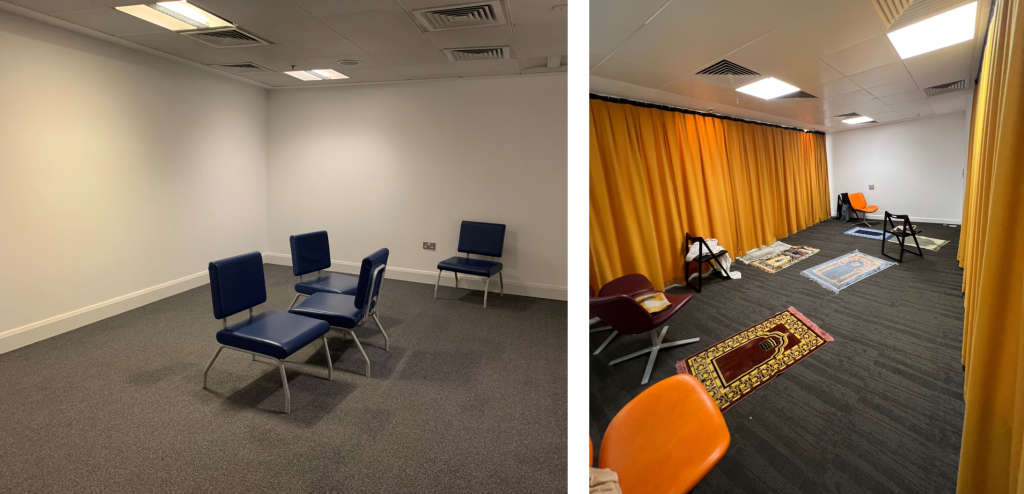
As well as visiting facilities, interviews were held with Railway Mission Rail Chaplains for Birmingham New Street and Euston stations and Network Rail headquarters in Milton Keynes and with Heathrow Airport chaplaincy. Survey and usage data for facilities at Gatwick and Heathrow Airports were also reviewed. This information provided valuable first-hand experience of design, operations, maintenance and security considerations relevant to facilities for large transport hubs. Insights were captured and systematically reviewed against developing design proposals for a generic HS2 layout. Some key findings are summarised below.
- Interviews highlighted the potential conflicts that can arise due to different religious practices and types of use and how these are accommodated or not in the way facilities are configured. These were particularly evident in facilities provided as a single room. Separation between staff and public was highlighted as a beneficial feature and accommodating gender-neutral use was also highlighted as beneficial to allow families to use a facility together.
- Differences in naming strategies were identified. The most common name was ‘Multi-Faith Room’, and was found at airports and railway stations, whereas facilities in shopping centres and sports facilities used for the same purpose were named ‘Silence Room’, ’Sensory Room’ and ‘Chapel’. Gatwick Airport uses the terms ‘Chapel and Prayer Room’. It was considered that these did not appropriately reflect the intended inclusive use of HS2 facilities by anyone, for prayer, quiet contemplation or a break from a busy environment and highlighted the impact this may have on how comfortable people may feel in deciding to use facilities. An early consideration therefore was that the name ‘Quiet Room’ should be adopted for HS2 as this suggests neutrality of use.
- Interviews highlighted general patterns of use. Airport and station facilities reported a continuous level of light use during the day with peaks occurring at Muslim prayer times and with Friday peaks being particularly busy. The need to accommodate these peaks was highlighted to avoid the need for queuing. Main users were generally identified as Christian and Muslim. Survey data provided by Heathrow Airport and Gatwick Airport supported these observations [Figure 2].
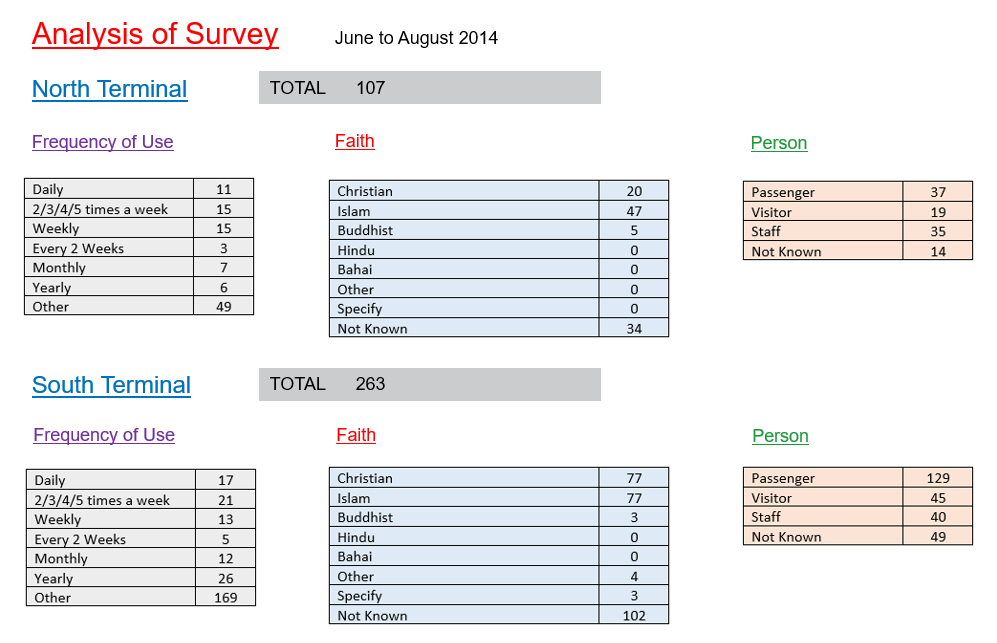
- Security considerations included the benefit and necessity of regular monitoring by staff, fixed opening times and CCTV in lobby areas, all to discourage misuse. It was highlighted that basic and clear rules should be made visible, principally to require basic respect between users. Issues relating to storage of religious items and loose furniture also became apparent.
- The Railway Children chief executive highlighted key work that is performed with British Transport Police (BTP) and the potential for having rooms that can also be considered a ‘safe space’ for vulnerable individuals to reside in whilst awaiting the BTP. To support the research, a briefing note titled ‘Safe Space Addendum’ [7] was produced to capture and record the identification of a potential future requirement for spaces with different operational considerations.
User identification and requirements
To outline the requirements for a space it is necessary to identify the groups anticipated to use it. Initial research included a review of the 2011 Census of Religious affiliation in England and Wales [8]. Sport England: Mapping Disability – The Facts (2016) [9] contains a wealth of information relating to the demographics of disabled people and their disabilities. Using this, the groups identified to be the core users of the quiet room facility were:
1) People from the following religions:
- Christianity
- Islam
- Hinduism
- Sikhism
- Judaism
- Buddhism
2) People with no religion
3) People with assistance dogs
4) Neurodiverse users:
- with learning difficulties
- with autism
- living with dementia
- with mental health needs
5) Blind and partially sighted users
6) Deaf and hard of hearing users
7) Wheelchair/walking aid users
A user requirements matrix was then developed to map requirements for quiet spaces for the identified user groups Interviews, questionnaires, site visits and discussions with a range of subject matter experts were conducted to gather input for the matrix from a range of sources and contexts.
To develop a detailed understanding of requirements, information from end users was gathered via a questionnaire requesting feedback on the use of faith and quiet rooms. The questionnaire was distributed to Atkins, HS2 Ltd and Network Rail employees and received nearly 100 responses. The responses were representative of people from a range of neurodiverse backgrounds and religions, as well as of people of no religion or belief. Figure 3 and Figure 4 provide an overview of the groups represented by the data collected.
The questionnaire asked a range of open and closed questions to gather information about experiences, preferences and requirements when using faith and quiet rooms. Responses to the questionnaire were filtered back into the requirements matrix, enabling similar and repeated comments to be identified and highlighted as being of importance. This approach enabled the individual context of the comment to be retained, such as religious background and other personal circumstances.
To gain further understanding of religions and beliefs, interviews were undertaken with individuals who had responded to the questionnaire. Specific requirements of the most prevalent religions, including prayer times, prayer routines and washing requirements were identified.
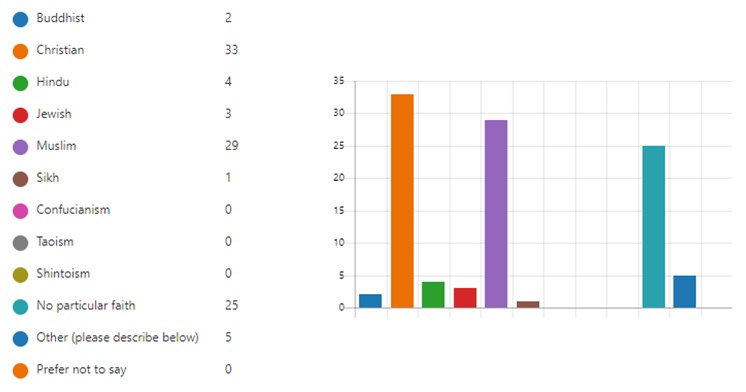

As well as having had involvement with development of the BSI PAS 6463:2022 Design for the Mind – Neurodiversity and the Built Environment – Guide [10], co-authors of this paper Maslin and Smith, have relevant specialist knowledge of neurodiversity and contributed to the matrix. In addition, further interviews were conducted on neurodiversity, for example with the Bristol Dementia Alliance where key topics included the uptake and usage levels of the quiet space at Bristol Airport and the management procedures currently in place and whether these were optimal.
The matrix highlighted several potential conflicts in terms of the requirements of users from different groups. For example, some religious groups require male/female separation for prayer. This presents a particular challenge if the facility provided is a single room, as the method for achieving separation is difficult and may discourage other users from using the space at the same time. Similarly, demand for the space to be quiet by families and neurodiverse users may conflict with the method of prayer by some groups who speak or sing during prayer. Similarly, a family or neurodiverse user who are seeking respite from the station environment may also cause disturbance to someone seeking a space for quiet or silent prayer. Table 1 below presents a summary of the matrix.
This analysis resulted in adoption of a cellular spatial approach providing a series of rooms to allow for flexibility of use by different users. This also provides opportunity for male/female separation, family prayer and neurodiverse use.
| Requirements | Christianity | Islam | Judaism | Hinduism | Sikhism | Buddhism | Mobility | Neurodiverse |
|---|---|---|---|---|---|---|---|---|
| Prayer Practice & Times | No fixed prayer time for majority | Five times a day at prescribed times – sunrise, midday, afternoon, sunset and dark | Three times a day | Minimum of twice a day – dawn and dusk | No fixed prayer time | No fixed prayer time. Monastic Buddhists follow rigid routine | Any time Estimated peak – 07:00-10:00am and 16:00-19:00pm | Any time Estimated peak – 07:00-10:00am and 16:00-19:00pm |
| Separation M/F & Privacy | Majority of Christians – no male and female separation | Male and female entrance/exit, prayer hall and ablution areas | Orthodox – men and women rigidly segregated | Males and females are separated during prayer | Men sit on one side and women on the other | No male and female separation for prayer | Some privacy may be of benefit | Range of different spaces to serve the purposes of people with differing neurosensory needs |
| Orientation | No specific orientation of prayer required | Use of Mihrab indicating direction to the Kabba in Mecca. It is essential that this direction is accurately established | Jewish law instructs prayer towards Jerusalem | Direction of temple should be such that devotee faces East for prayer | No orientation requirements | No orientation requirements | Orientation of prayer is relevant for disabled users depending on the requirements of their chosen religion or belief | Any direction prayer should be comfortable from a sensory point of view |
| Position for prayer and ergonomic requirements | Seated or kneeling. Can also be performed walking, prostrated or standing. Sometimes with arms outstretched | Standing, kneeling and prostrated. Allow at least 0.75 m2 per person | Standing or sitting | Namaste pose. No seating is required | Seated on the floor | Seated on the floor | A mixture of seating options e.g., fixed or removable, with or without armrests | N/A |
| Shoe removal | No shoe removal required | No shoes allowed past main entrance | No shoe removal required | Expectation to remove shoes | Expectation to remove shoes | Expectation to remove shoes | May be difficult or not possible without assistance | Could be tactile sensory issues related to not wearing shoes |
| Facilities for washing and toilet provision | Ablution is not commonly practised amongst Christians it is practised by Oriental Orthodox Christians | Ablution to wash hands, elbows, faces, behind the ears and feet in preparation for prayer. Toilets should be in compartments. Toilets may not be situation under or over the prayer hall and no drainage pipes whatsoever | Ablution is important for Orthodox Jewish Prayer Water for ablution must be in state of natural purity, not discoloured | Hindus may wish to wash and change before prayer | Sikhs may wish to wash the hands and feet before prayer as a form of ablution. Washrooms are separate for males and females. | Buddhists wash their hands and cleanse their mouth before prayer | Unisex wheelchair accessible toilet to be provided in a separate cubicle adjacent to the quiet space. Baby changing | Washing and water can have sensory aspects – not likely to be critical to functioning of quiet space |
| Building services | N/A | Toilets may not be situated under or over the prayer hall and no drainage pipes whatsoever should pass under or over it | Lighting should be high as prayer spaces are used after dark Orthodox Jews need to have automatic lighting controls | Room is available for every member of the family | N/A | N/A | Lighting levels should be uniform in accordance with BS8300. For automatic lighting sensors should be located to detect presence of person anywhere within the space Taps – poor dexterity can operate single level action mixer | Low lighting generally considered relaxing. Reduce flickering Floor coverings and curtains can help reduce and soften noise |
| Material palette and finishes | N/A | N/A | N/A | Leather finishes to be avoided | N/A | N/A | Slip resistance Good colour contrast Consider how colour of walls and floors can help elderly, visually impaired and disabled navigate around the room | Use of mirrors and reflective materials not recommended. Surface patterns should be neutral as complex patterns can cause visual stress and confusion |
| Daylight provision | N/A | During Ramadan, Muslims fast from dawn to dusk | N/A | N/A | N/A | N/A | View to outside is encouraged | Natural light can help reduce stress and claustrophobia. Use of window light and plants are recommended. |
Determining occupancy
BS8300-2:2018 [4] does not include a method to determine the size of quiet or faith facilities. A method was therefore needed that considered a range of context specific factors such as anticipated demand and time required to use a facility. It was identified that BS 6465-1:2006+A1 2009 [11] includes a suitable method to calculate the required provision of sanitary appliances for public toilets that could be adapted to calculate the maximum expected occupancy numbers for the quiet spaces, for both customers and staff.
To set the criteria for this method, information from the 2011 England and Wales Census [8] was used to identify religious affiliations within the catchment areas of each station. The proportion of population likely to use quiet rooms for reasons of neurodiversity were derived from national statistics [12]. Different values for occupancy times for faith and quiet use were also estimated.
Review of user data and interviews showed that Christians and Muslims will be the most frequent users, with Christian use likely to be spread throughout the day, and Muslim use at specific prayer times, with morning prayers aligning with peak hour station demand, thus generating a peak demand for faith use which could be estimated for each station. It was also identified that peak neurodiverse use would likely not coincide with peak faith use and would generate a lower demand.
This information was used to estimate maximum expected occupancy for each station for peak hour demand in 2041. This is presented in Table 2 below.
| Station | Facility | Maximum Expected Occupancy | |
| Religion or belief | Neurodiversity | ||
| Euston | Customer | 20.3 | 10.0 |
| Staff | 3.3 | 2.7 | |
| Old Oak Common | Customer | 8.2 | 4.3 |
| Staff | 1.6 | 1.5 | |
| Interchange | Customer | 3.7 | 1.5 |
| Staff | 1.0 | 0.8 | |
| Curzon Street | Customer | 5.2 | 2.1 |
| Staff | 1.6 | 1.3 | |
Facility design
Several key design decisions were required to establish an approach that would ensure facilities are accessible and inclusive for a wide range of users whilst providing suitable space to benefit health and wellbeing.
There is a need to provide quiet facilities for both customers and staff. Information gathered through the stakeholder engagement and review of existing facilities led to the view that customer and staff facilities should be independent of one another. Since the purpose of use, length of use and anticipated occupancy numbers differ greatly between customers and staff the associated sizing is also different.
The proximity of the customer facility to other services within the station was identified as an influencing factor on its arrangement – for example proximity to toilets or areas where staff are likely to be present. Also, accommodating estimated peak occupancy within the station context presented challenges in relation to available space and the opportunity to influence the proximity of the facility to other services.
Space constraints meant that it would not be feasible for all the stations to accommodate the optimum facility, therefore consideration of operation and how the spaces would be used was required to determine acceptable size without significantly compromising user requirements.
The final size of quiet rooms at each station varied due to predicted occupancy, but each satisfied the following key ‘rules’ for a quiet room facility:
- Provision of more than one room allows for different beliefs, genders and use (i.e., religion or belief and/or neurodiversity
- One room is to be bookable thereby providing opportunity for planned use, whilst still providing others with opportunity for spontaneous use.
- Provision of designated area for shoe removal if desired by users.
- Provision of accessible facilities provide opportunity for washing before prayer or washing for other circumstances.
- Provision of an accessible WC for wheelchair and scooter users where not located in close proximity.
Station specific decisions based on predicted occupancy were also required in relation to the number of rooms at each station. BS8300-2:2018 [4] does not state whether a quiet room facility should be a single room or a suite of rooms. Initial user research showed that some faith groups have requirement for male/female separation for prayer and this was subsequently supported by the data gathered via the user engagement questionnaire. Providing more than one room gives opportunity for groups to make this separation, and making the rooms gender neutral, provides flexibility in how this can be achieved. In facilities where there are more than two rooms this provision gives adequate flexibility for groups requiring separation and those that don’t to use the facility in parallel. There is also benefit in this arrangement for neurodiverse users whose use of the room may be very different.
It was considered that staff facilities should also be provided with more than one room to allow flexibility of use, however as usage numbers are anticipated to be lower, provision could be reduced to two rooms.
It was also considered that where possible, all rooms in a suite would be the same size and square in shape to give a consistent arrangement across rooms. Consistency of arrangement is considered important as it supports the rooms being interchangeable.
During peak usage it is plausible that provision for neurodiverse users and unplanned use is reduced significantly by users from religious groups using the facility at particular times. Therefore, the provision of other designated alternative quiet zones in less busy parts of the station and areas outside the station was identified as necessary to support these user groups.
Similarly, the ability to book a room provides some user groups with confidence in their travel to ensure the space is available for them when required. Therefore, it was considered that all customer facilities should have a room that is bookable by neurodiverse users. The bookable room within any given facility is not pre-determined by the designers and should be designated on a case-by-case basis, ensuring that the room that best meets the user’s needs can be reserved.
A designated shoe removal area located at the entrance of quiet rooms provides users with the opportunity to remove their shoes prior to entering the quiet rooms if they so wish. Shoe removal was found to be a common practice across several but not all religions before prayer. It was also found that some would not want to remove their shoes. Consequently, the opportunity for shoe removal was considered a key requirement whilst not mandating shoe removal for all users.
Ablution is also a common practice prior to prayer for several but not all religions. The advantages and disadvantages of accessible shower compared to wudu facilities were assessed. The ‘Muslims at Atkins’ Yammer group provided essential input and gave a detailed understanding of the requirements of Islamic ablutions. It was considered that the design of the ablution facility should not suggest bias towards a single faith or group and should be gender neutral and fully accessible for people who may need to use the wash facilities for reasons unrelated to prayer.
Review of existing facilities identified the need for furniture but also security issues with loose items therefore it was considered that fixed furniture should be provided in the form of a row of bench seating on two adjacent sides of each room.
Through the design process, optimum size for areas and rooms comprising quiet facilities were defined as follows:
- Quiet rooms – 16 m2 configured as a square room measuring 4m by 4m;
- Access corridor width – 1.8m wide;
- Ablution – 5.2 m2;
- Accessible toilet where provided – 2.2m x 1.7m; and,
- The shoe removal area shall allow sufficient space for a wheelchair user to manoeuvre.
To allow some flexibility in implementation, acceptable minimum sizes of 12 m2 and 9 m2 were also defined, these being subject to location, anticipated demand and patterns of use.
Figure 5 and Figure 6 below show the indicative layouts for the customer and staff facilities respectively.
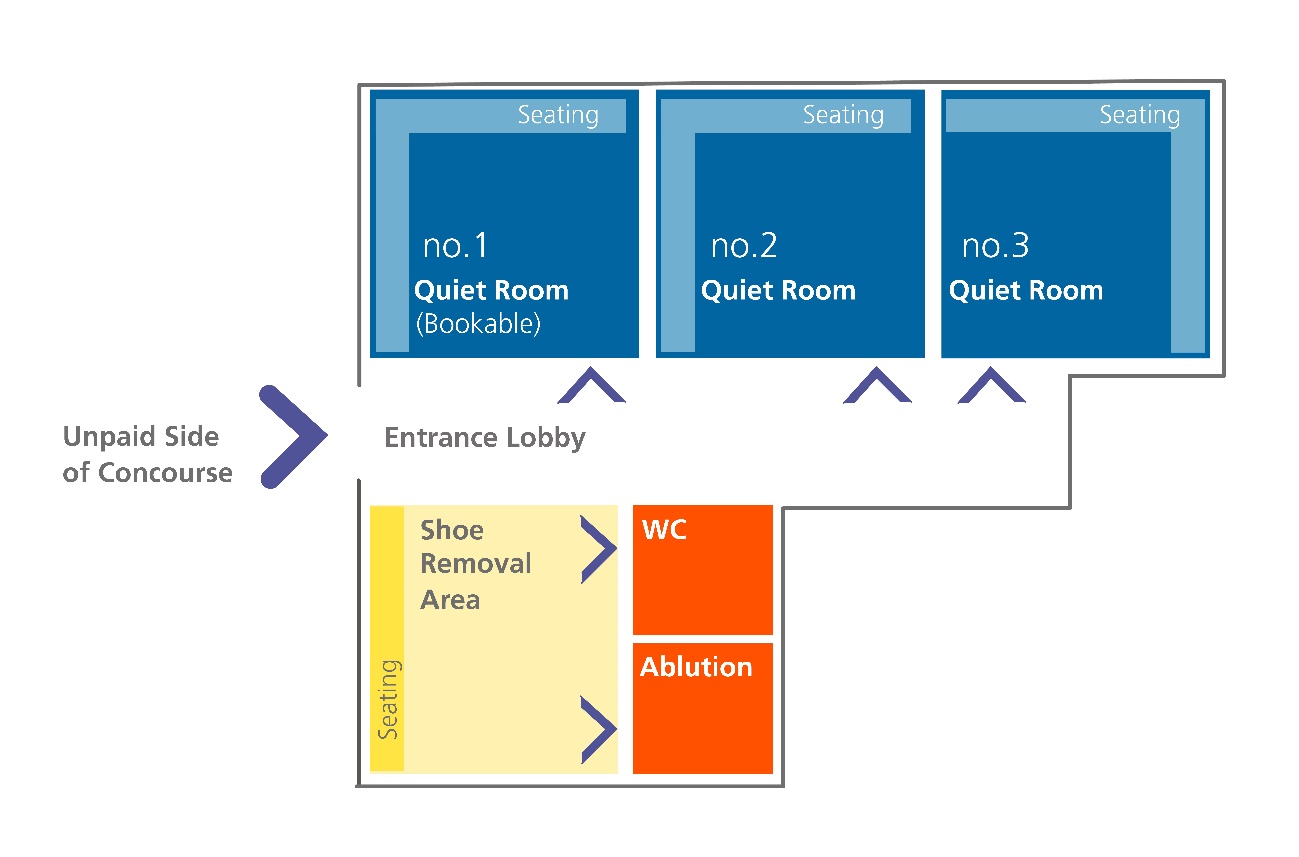
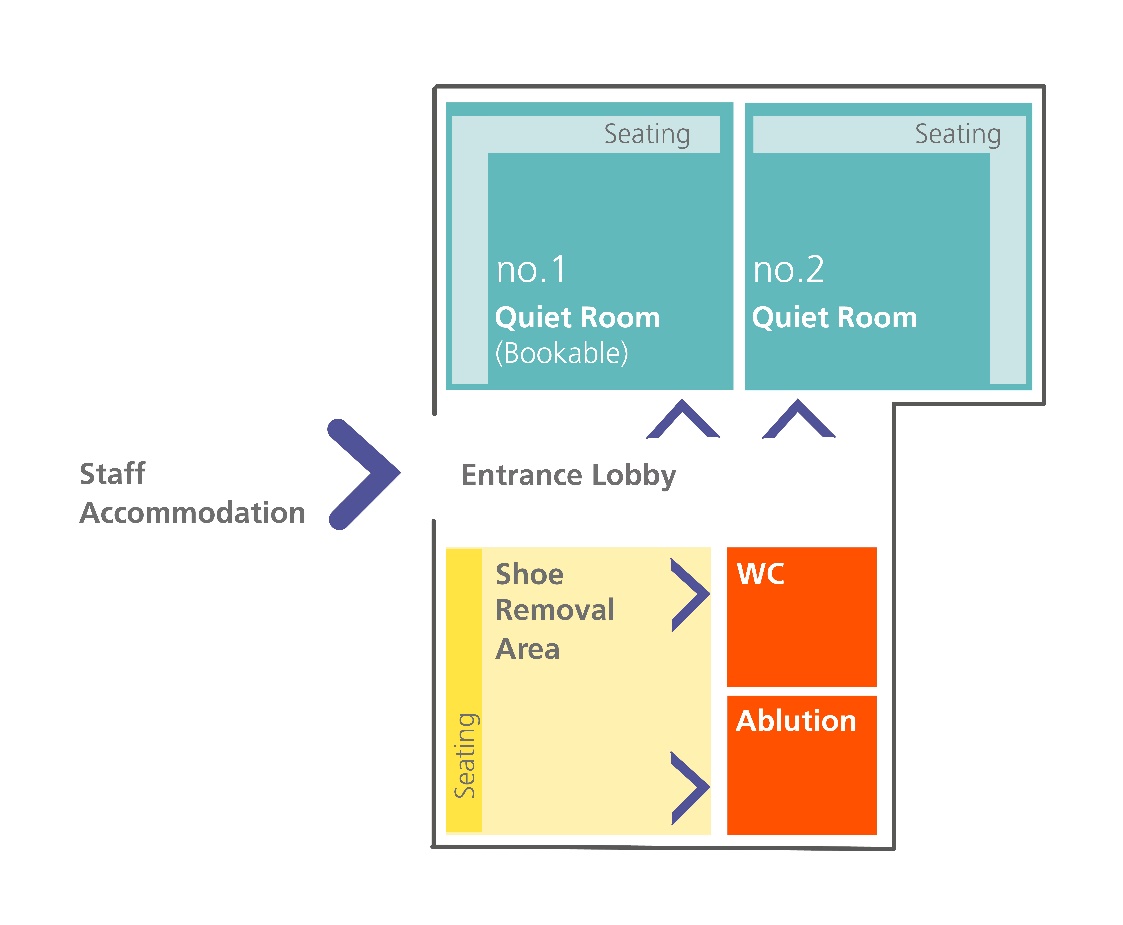
Figure 7 presents the layout of the ablution facility. Assessment of the user requirements identified that features in accordance with Figure 40 in BS8300-2:2018 [4] should be provided:
- Sufficient space for a wheelchair user to manoeuvre;
- Fixed seating with arm rests and back support;
- Two fixed anti-vandal shower heads, one set at 800mm and the other at 450mm above floor level;
- Washbasin for wheelchair users and upper body washing;
- Clear indication of the purpose of the taps and how they operate;
- Doors that open outwards;
- Paper towel dispenser and bin recessed within the wall; and,
- Low noise hand dryer.
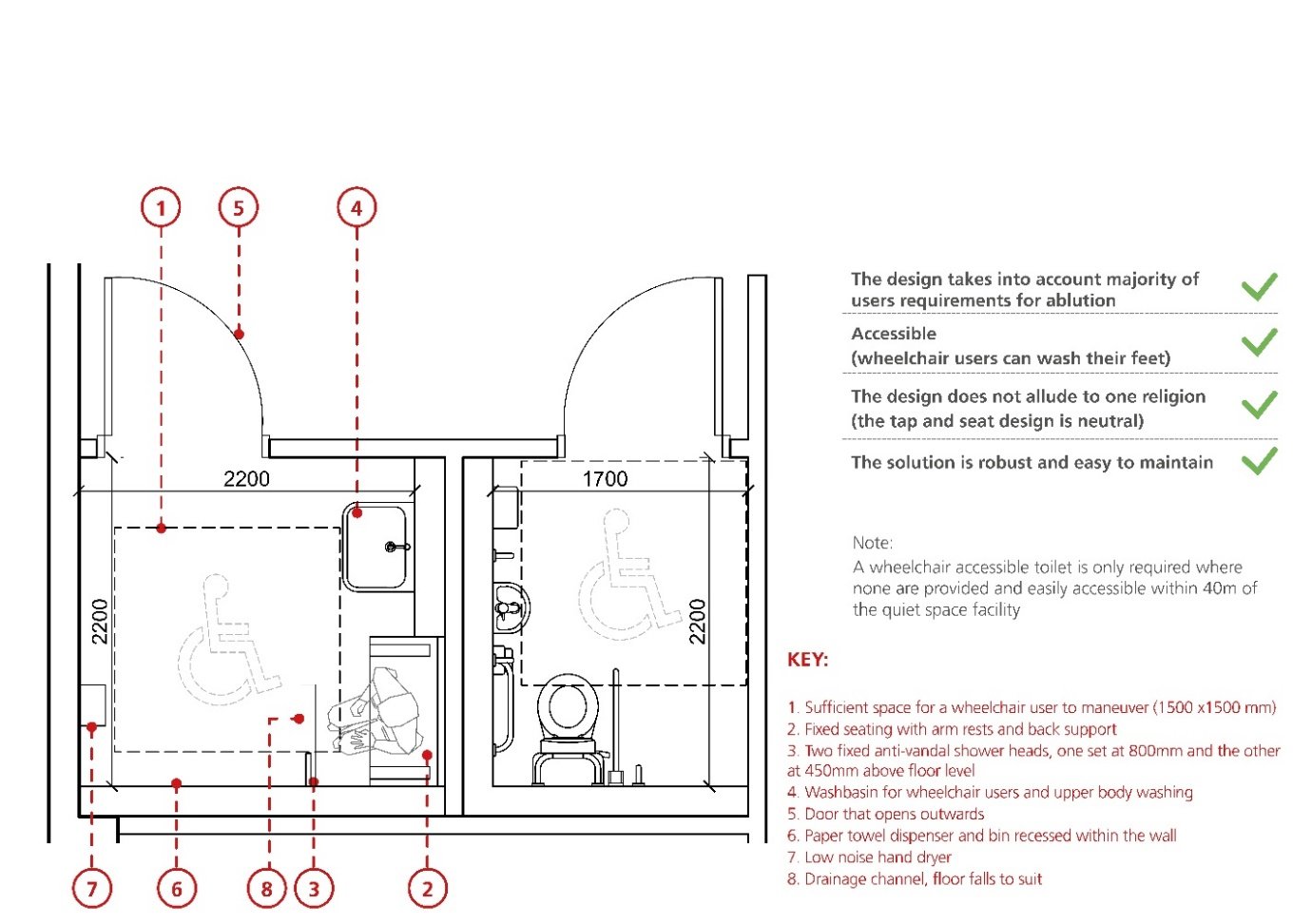
Other considerations
In addition to the design principles of the core facility, other design considerations were identified that enhance user experience and these were included in the specification:
- Usage of the facility should be monitored, and assistance available nearby. There is benefit in the rooms being located close to other facilities and services within the station such as Customer Information Points, customer toilets, station reception and British Transport Police customer facing reception where provided.
- To ease demand on the quiet room during peak times, it was recommended that more informal Quiet Zones be designated in less busy areas of the station concourse and public realm. Quiet zones should be signposted and integrated with station seating and other customer facilities. (Quiet Rooms and Quiet Zones are collectively referred to as Quiet Spaces).
- Inclusion is essential for the facility to be a success. The review of existing facilities identified the commonly used term ‘Multi-Faith’ as not inclusive or conducive to the purpose of the facility. Therefore, facilities are to be named and signed ‘Quiet Rooms’ which enables greater inclusion without bias towards a particular religion or belief, whilst opening-up the opportunity for use by others seeking to manage sensory overload. In addition to this, religious symbols should not be used, as this may dissuade people from using the space as intended.
- The user engagement questionnaire indicated that views to outside space may be beneficial as this can reduce stress and improve comfort in the indoor environment. Due to constraints of the station layout, it may not be feasible to provide access to windows and/or natural light. In this instance, light could be ‘borrowed’ from neighbouring indoor spaces. Vision panels on the internal doors can assist with lighting provision and enable individuals to establish the availability status of the room.
- Research into existing facilities at Crewe Station’s ‘Calm Corner’ showed the inclusion of biophilic design in the form of ‘living’ walls and plants. Biophilic design can support cognitive function, physical health, psychological well-being and provides a calming effect for users.
- User research highlighted the importance of selecting suitable materials and finishes within the space, as certain fabrics such as leather can be deemed offensive to some religions. Similarly for neurodiverse users, complex patterns can cause sensory overload and should be avoided. The use of neutral and calming colours is beneficial for enabling a calm environment that is inclusive to all users.
- Detail design of the Quiet Rooms provides an opportunity to work with an artist, maker or designer to create a calm and tranquil environment. This is supported by HS2 Art Strategy [13] and the HS2 Art Approach [14] and individual art strategies for each station. This would require collaboration with the station designer to create an integrated environment and would allow colour, light, texture, materials, surfaces and furniture to complement each other to create beautiful, sensitive and reflective spaces.
Conclusions and recommendations
The authors consider that the completed HS2 Quiet Spaces Specification [15] provides valuable lessons for inclusive design and accessibility, and requirements capture, that are transferrable to other areas of building design and infrastructure projects. It is intended that the evidence gathered from this research will support the next revision of the recently published PAS Design for the Mind and up and coming update to BS8300-2:2018. [4]
The research has resulted in the formulation of a detailed technical specification that includes design requirements, data sheets, operations and security guidance and a sizing methodology. The specification has been approved through HS2 Ltd’s Technical Authority Panel and included with HS2 Ltd’s station standards baseline. It will be used as the basis of design for the quiet rooms for the Phase One HS2 stations – Euston, Old Oak Common, Interchange and Curzon Street.
Though based on station requirements the research and methodology for the design of the spaces has also informed the technical requirements and design development of the HS2 Phase One depots: Washwood Heath, including the Network Integrated Control Centre and Calvert Infrastructure Maintenance Depot.
Feedback received from HS2 subject matter experts and other stakeholders such as the Network Rail Built Environment Accessibility Panel has been positive, and the process of engagement led to a strong cross-discipline integrated design innovation.
There is opportunity to undertake further work using the outputs of the ‘Safe Space Addendum’ [7] to better understand requirements and the potential to make provision for safe spaces for vulnerable individuals.
The next phase of design requires integration into station designs and is crucial to the success of the Quiet Spaces. Within the constraints of the specification there is opportunity for individual station designers to develop sensitive designs and station specific responses for material and finishes. There is also opportunity to make imaginative use of the station concourse and public realm designs in designating less formal Quiet Zones.
Acknowledgements
The authors would like to acknowledge the contribution of Phil Seaward from Atkins (EDP), in providing valuable design input throughout the project. We would also like to thank James Nicoll from Jacobs (EDP) for his collaborative input to assessing demographics, demand and occupancy.
References
- High Speed Two Ltd – ‘High Speed Two Limited’s equality, diversity and inclusion policy’ (2022)
- Legislation.gov.uk –‘Equality Act’ (2010)
- High Speed Two Ltd – ‘Inclusive design policy’ (2020)
- British Standards Institute, BS8300-2:2018 – ‘Design of an Accessible and Inclusive Built Environment’ (2018).
- Network Rail – ‘Design Manual NR/GN/CIV/300/04 Inclusive Design’ (2020)
- London Legacy Development Corporation (LLDC) – Inclusive Design Standard, (2019).
- High Speed Two – ‘HS2 Quiet Spaces Safe Space Addendum’.
- Census of Religious Affiliation in England and Wales (2011).
- Sport England – ‘Mapping Disability – The Facts’ (2016)
- British Standards Institute PAS 6463:2022 ‘Design for the Mind- Neurodiversity and the Built Environment- Guide’ (2022).
- British Standards Institute, BS 6465-1:2006– ‘Sanitary Installations, Part 1: Code of practice for the design of sanitary facilities and scales of provision of sanitary and associated appliances’ (2009).
- Department for Transport – ‘Transport: disability and accessibility statistics, England’ (2020)
- High Speed Two Ltd – ‘High Speed Two Art Strategy’ (2017).
- High Speed Two Ltd- ‘High Speed Two Art Approach’ (2017).
- High Speed Two Ltd -‘High Speed 2 Quiet Spaces Technical Specification’ (2022).
Peer review
- Fiona KingHS2 Ltd

